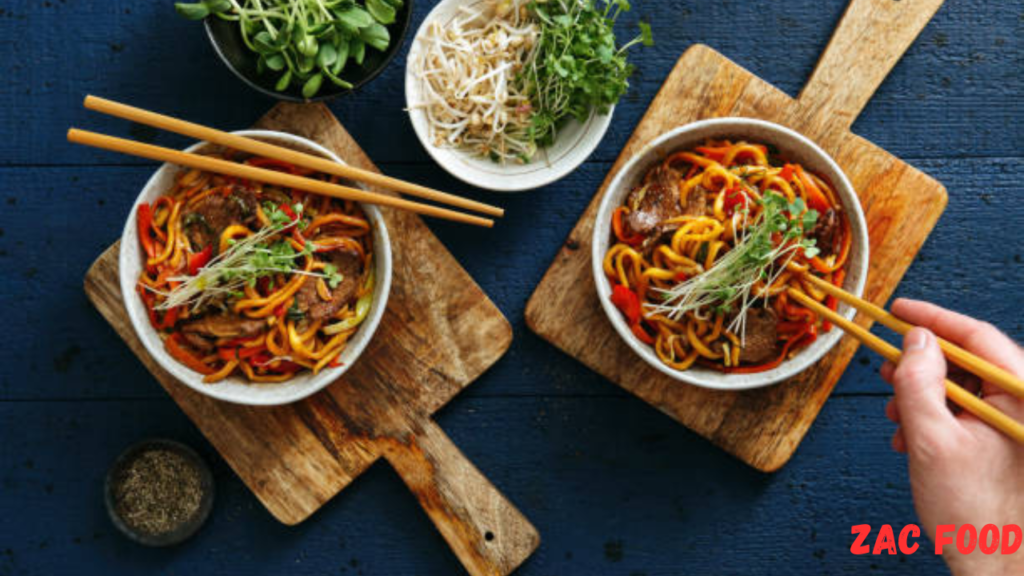Chinese cuisine has long held a cherished spot in the global culinary landscape. Its rich flavors, diverse ingredients, and profound cultural significance make it a favorite for food lovers everywhere. In 2024, Chinese trendy food continues to evolve, blending tradition with innovation. This article explores the journey of Chinese food from humble street eats to sophisticated gourmet feasts, highlighting the key trends shaping this transformation.
Historical Context
Traditional Chinese Street Food Origins
Chinese street food has deep roots, dating back centuries. Markets and street vendors have always been a vital part of Chinese culture, offering affordable, quick, and delicious meals to the masses. These foods often reflect the local flavors and culinary traditions, providing a taste of China’s rich gastronomic heritage.

Early Influences on Chinese Cuisine
Chinese cuisine has evolved through various influences, including trade along the Silk Road, foreign invasions, and colonial periods. Each wave of influence brought new ingredients and cooking techniques, enriching the culinary tapestry of China.
The Journey from Traditional to Trendy
As China modernized, so did its food. Traditional street foods began to transform, adopting modern twists while preserving their essence. This evolution mirrors China’s broader socio-economic changes, with food trends often reflecting shifts in society and consumer preferences.
Street Eats: The Heart of Chinese Cuisine
Popular Street Foods in China
Street food remains at the heart of Chinese cuisine. Some of the most popular street foods include dumplings, skewers, baozi (steamed buns), and jianbing (savory crepes). These dishes are not only delicious but also provide a convenient meal for people on the go.
Regional Variations and Specialties
China’s vast landscape offers a plethora of regional specialties. In the north, you might find hearty lamb skewers, while the south boasts delicate dim sum. Each region’s street food reflects its unique cultural and geographical influences.
Influence of Street Food on Modern Chinese Cuisine
Modern Chinese trendy food often draws inspiration from these traditional street eats. Chefs and food innovators reinterpret these classics, incorporating contemporary ingredients and techniques to appeal to today’s diners.
Factors Driving Food Trends
Economic Growth and Urbanization
China’s rapid economic growth and urbanization have significantly influenced food trends. Rising incomes and a growing middle class have increased demand for diverse and upscale dining options. Urbanization has also led to a more fast-paced lifestyle, boosting the popularity of convenient yet high-quality meals.
Influence of Social Media and Food Bloggers
Social media platforms like Weibo, Douyin (TikTok), and Instagram play a crucial role in popularizing Chinese trendy food. Food bloggers and influencers share their culinary discoveries, making new dishes and restaurants viral sensations overnight.
Rise of Foodie Culture Among Younger Generations
The younger generation’s passion for food exploration drives the innovation in Chinese trendy food. Millennials and Gen Z seek out unique dining experiences, often prioritizing novelty and presentation, which pushes chefs to continuously innovate.
Innovative Ingredients and Techniques
Fusion of Traditional and Modern Ingredients
Modern Chinese trendy food often blends traditional ingredients with contemporary elements. For example, you might find a classic dish like Peking duck paired with truffle sauce or dumplings filled with foie gras. These combinations create exciting new flavors while respecting culinary traditions.
Use of Advanced Cooking Techniques
Advanced cooking techniques, such as molecular gastronomy and sous-vide, are making their way into Chinese kitchens. These methods allow chefs to experiment with textures and flavors, elevating traditional dishes to gourmet levels.
Examples of Innovative Dishes
Examples of innovative Chinese trendy food dishes include tea-smoked salmon with Sichuan pepper, molecular xiaolongbao (soup dumplings), and matcha-infused noodles. These dishes exemplify the creativity and skill of modern Chinese chefs.
Health and Sustainability
Growing Trend of Healthy Eating
As health consciousness rises globally, Chinese trendy food is also shifting towards healthier options. Many modern dishes emphasize fresh vegetables, lean proteins, and whole grains, catering to health-conscious consumers.
Incorporation of Organic and Sustainable Ingredients
Sustainability is becoming a key focus in Chinese trendy food. Chefs and restaurateurs are increasingly sourcing organic and locally-produced ingredients, reducing their environmental footprint and promoting sustainable practices.
Impact of Environmental Awareness on Food Trends
Environmental awareness influences food trends by encouraging the use of eco-friendly practices. This includes reducing food waste, using biodegradable packaging, and promoting plant-based diets, all of which are becoming more prevalent in the Chinese trendy food scene.
Gourmet Feasts: The Rise of Haute Cuisine
Emergence of Chinese Fine Dining
Chinese fine dining has seen significant growth, with chefs elevating traditional dishes to gourmet status. Fine dining establishments focus on presentation, quality ingredients, and innovative cooking techniques to provide an unforgettable culinary experience.
Influence of International Culinary Techniques
Chinese chefs are incorporating international culinary techniques, such as French patisserie skills or Japanese precision, into their cooking. This fusion of styles creates sophisticated dishes that appeal to global palates.
Notable Gourmet Chinese Restaurants
Notable gourmet Chinese restaurants include Ultraviolet by Paul Pairet in Shanghai, which offers a multi-sensory dining experience, and Bo Innovation in Hong Kong, known for its avant-garde approach to Chinese cuisine.
Regional Trends and Innovations
Trendy Foods from Beijing
In Beijing, traditional dishes like Peking duck are being reimagined with modern twists. Trendy eateries are offering deconstructed versions of classic dishes, presenting them in innovative ways that appeal to modern diners.
Innovations in Shanghai Cuisine
Shanghai’s culinary scene is renowned for its creativity. Chefs in the city are experimenting with fusion cuisine, combining local flavors with international influences. This results in dishes like Shanghainese tapas or seafood platters with Asian spices.
New Food Trends from Sichuan Province
Sichuan cuisine, known for its bold and spicy flavors, continues to innovate. New trends include incorporating Sichuan pepper into desserts and using it in molecular gastronomy to create unique taste experiences.
Fusion Cuisine
Blending Chinese and Western Culinary Styles
Fusion cuisine blends Chinese culinary traditions with Western techniques and ingredients. This creates unique dishes that offer the best of both worlds, appealing to a wide range of tastes.
Popular Fusion Dishes
Popular fusion dishes include Peking duck pizza, dumpling burgers, and bao tacos. These creations marry the flavors of Chinese cuisine with Western favorites, creating something entirely new and exciting.
Influence of Global Flavors on Chinese Cuisine
Global flavors are increasingly being integrated into Chinese trendy food. Ingredients like quinoa, avocado, and truffle are finding their way into traditional Chinese dishes, reflecting a more globalized culinary landscape.
Street Food Goes Global
International Popularity of Chinese Street Food
Chinese street food has gained international popularity, with dishes like baozi, dumplings, and spring rolls becoming global favorites. This popularity has sparked interest in other traditional street foods.
Chinese Street Food in Western Countries
In Western countries, Chinese street food is often adapted to local tastes while maintaining its core flavors. Food trucks and pop-up stalls offer authentic Chinese snacks, introducing them to a broader audience.
Street Food Festivals and Events
Street food festivals and events celebrating Chinese trendy food are becoming more common. These festivals provide a platform for showcasing traditional and modern Chinese dishes, fostering cultural exchange.
Technology and Food Delivery
Impact of Technology on Food Trends
Technology plays a significant role in shaping food trends. Online reviews, food photography, and recipe videos influence what people eat and where they dine. Technology makes it easier to discover and share Chinese trendy food.
Growth of Food Delivery Apps
Food delivery apps like Meituan and Ele.me have revolutionized the way people enjoy Chinese trendy food. These apps offer convenience and a wide variety of options, making it easier than ever to try new dishes.
Virtual Restaurants and Ghost Kitchens
Virtual restaurants and ghost kitchens, which operate solely for delivery, are becoming more prevalent. These establishments allow chefs to experiment with new concepts and reach a broader audience without the overhead of a traditional restaurant.
Celebrity Chefs and Food Influencers
Prominent Figures in Chinese Trendy Food
Prominent figures in Chinese trendy food include chefs like Da Dong, known for his artistic approach to Peking duck, and influencers like Li Ziqi, who shares traditional cooking methods with a modern twist through her videos.
Influence of Celebrity Chefs on Food Trends
Celebrity chefs set culinary trends by introducing innovative dishes and techniques. Their influence extends beyond their restaurants, inspiring home cooks and other chefs to experiment with new ideas.
Role of Social Media Influencers
Social media influencers play a crucial role in promoting Chinese trendy food. Their posts, videos, and reviews can make a dish or restaurant go viral, driving interest and traffic.
The Future of Chinese Trendy Food
Predictions for Future Food Trends
Future food trends in Chinese cuisine may include more plant-based options, increased use of technology in dining experiences, and further fusion of traditional and international flavors.
Potential Impact of Cultural and Economic Changes
Cultural and economic changes will continue to shape food trends. As China becomes more interconnected with the world, its food culture will reflect a blend of local and global influences.
Evolution of Consumer Preferences
Consumer preferences are likely to evolve towards more health-conscious and sustainable choices. This shift will drive innovation in Chinese trendy food, pushing chefs to create dishes that are both delicious and environmentally friendly.
Cultural Impact
How Food Trends Reflect Cultural Shifts
Food trends often mirror broader cultural shifts. The evolution of Chinese trendy food reflects changes in society, such as increased urbanization, global interconnectedness, and a growing emphasis on health and sustainability.
Influence of Chinese Trendy Food on Global Culinary Scene
Chinese trendy food influences the global culinary scene by introducing new flavors and cooking techniques. This exchange enriches international cuisine and fosters a deeper appreciation for Chinese culinary traditions.
Role of Food in Cultural Exchange
Food serves as a powerful medium for cultural exchange. Chinese trendy food, with its blend of traditional and modern elements, helps bridge cultural gaps and fosters mutual understanding.
Read More:How does the cooking media impact food culture and crusine
FAQs
What are 5 popular Chinese dishes?
What is the most popular style of Chinese food?
What food is popular in Chinese culture?
What are some unique Chinese foods?
What is China’s national dish?
Conclusion
The journey of Chinese trendy food from street eats to gourmet feasts is a testament to the dynamic nature of cuisine. Embracing these evolving food trends is essential for both consumers and the food industry. As we look to the future, the continued innovation and creativity in Chinese cuisine promise exciting new culinary experiences.

